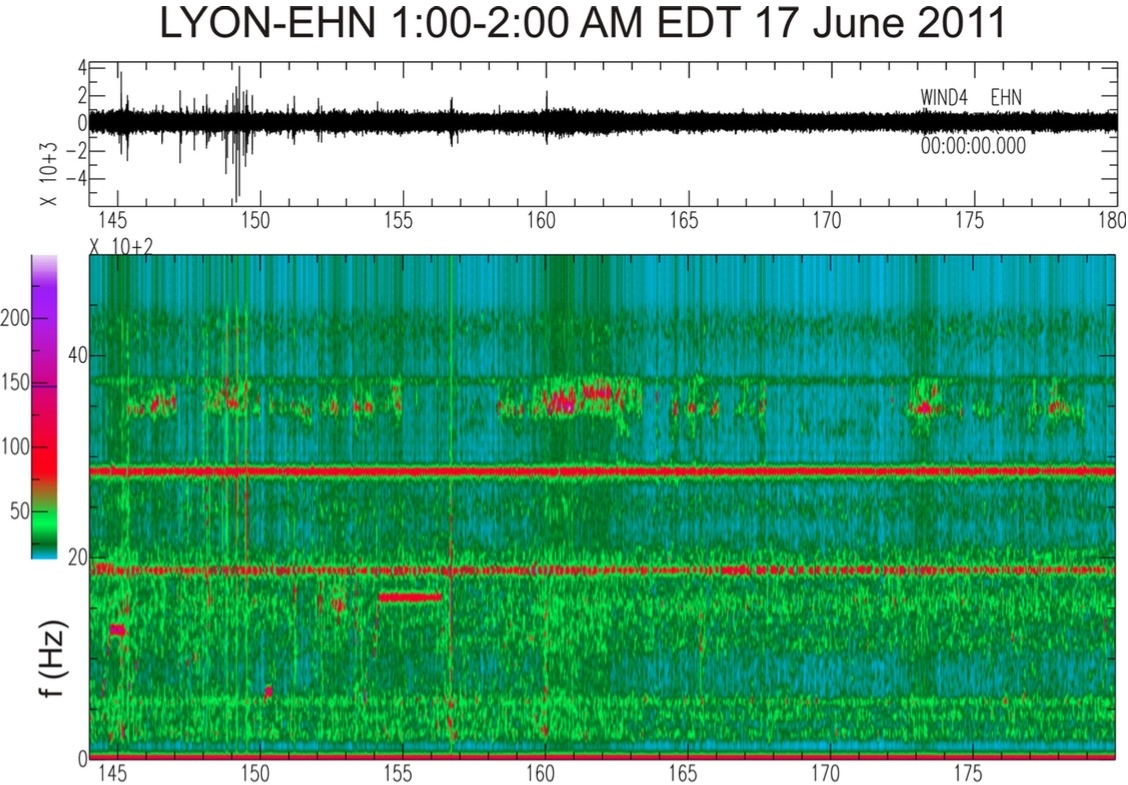The industrial cacophony that keeps Windsor awake just won’t go away.A key to the answer remains under lock and key in a government filing cabinet, kept secret from the public.Residents of the industrial Canadian city, which lies just across the river from Detroit, have been experiencing a monotonous type of noise pollution that is usually just referred to as ‘The Hum,’ and it’s been happening for years. The hum ranges from distant booms to a low tone that leaves locals wondering if they’re hearing things. It’s such a phenomenon, a feature documentary of it is in the works.Now, reports suggest the hum has returned — even though some locals say it’s never really gone away.
“It’s persistent,” Brian Masse, Member of Parliament for Windsor West, told VICE News. “It gets better and worse,” depending on development across the water from the city.The past week appears to be a flare-up in activity, although nobody seems quite sure if the source of the noise is the same as before. Some residents say the hum is so powerful this time, that it can rattle glassware in cupboards. “C’mon, give me a break. Let us get some sleep. Let us get some peace and quiet,” Mike Provost told the Windsor Star. “It sounds like the Enterprise going into warp speed.”Obviously, the hum has become a source for conspiracy. TV host Joe Rogan stoked some of the theories on his Syfy show, blaming the hum on a secret American government research project that could be used to control the weather. The reality is likely more mundane.The source of the noise is believed to be the blast furnaces on nearby Zug Island, the industrial strip of land in the middle of the Detroit River, on the American side of the border. Releasing pressure from the furnaces can make a terrible racket, but it is necessary to keep them from exploding. The theory goes that the sound reverberates off metal drums and mechanical equipment, compounding the hum and carrying it across the Detroit River.Just about every level of government has thrown their efforts behind trying to beat the hum, but nobody on either side of the border has even confirmed the source. A report commissioned by the Canadian government has been kept secret for two years. No one is sure why.Bob Dechert, who had served as a parliamentary secretary to the foreign affairs minister, was even tasked with visiting Windsor and Zug Island to study the source of the hum. He vowed afterwards to “isolate the source of the Windsor Hum so that a solution can be implemented in due course.”The first study, commissioned by the Ontario government in 2011, confirmed the hum but could not source its location.A second study came from the federal government. It, however, remains unpublished. With $60,000 CAD in public money, scientists ran acoustics tests throughout Windsor to try and isolate the source of the hum. A summary on the government’s website — the only details of the investigation that has been published — says “while it is not possible to ascertain the exact source of the Hum, possible sources may include quarry activity or industrial ventilation systems.” It’s that report, or at least the summary of it, that identified the possible source of the noise as US Steel’s blast furnaces.Masse, who represents the opposition New Democratic Party, says keeping the report secret amounts to “muzzling” the scientist who wrote it.Colin Novak, the University of Windsor engineering professor who did the study, did not return requests for comment.One request asking for the report under Canada’s access to information system was denied by the government, who claimed an exemption to avoid releasing it.“If they’re afraid to release information that is done on Canadian soil, that is done by a Canadian governmental regulatory agency — and report back to the Canadian taxpayers who have funded this — because of foreign pressure, then shame on them.”
“C’mon, give me a break. Let us get some sleep. Let us get some peace and quiet,” Mike Provost told the Windsor Star. “It sounds like the Enterprise going into warp speed.”Obviously, the hum has become a source for conspiracy. TV host Joe Rogan stoked some of the theories on his Syfy show, blaming the hum on a secret American government research project that could be used to control the weather. The reality is likely more mundane.The source of the noise is believed to be the blast furnaces on nearby Zug Island, the industrial strip of land in the middle of the Detroit River, on the American side of the border. Releasing pressure from the furnaces can make a terrible racket, but it is necessary to keep them from exploding. The theory goes that the sound reverberates off metal drums and mechanical equipment, compounding the hum and carrying it across the Detroit River.Just about every level of government has thrown their efforts behind trying to beat the hum, but nobody on either side of the border has even confirmed the source. A report commissioned by the Canadian government has been kept secret for two years. No one is sure why.Bob Dechert, who had served as a parliamentary secretary to the foreign affairs minister, was even tasked with visiting Windsor and Zug Island to study the source of the hum. He vowed afterwards to “isolate the source of the Windsor Hum so that a solution can be implemented in due course.”The first study, commissioned by the Ontario government in 2011, confirmed the hum but could not source its location.A second study came from the federal government. It, however, remains unpublished. With $60,000 CAD in public money, scientists ran acoustics tests throughout Windsor to try and isolate the source of the hum. A summary on the government’s website — the only details of the investigation that has been published — says “while it is not possible to ascertain the exact source of the Hum, possible sources may include quarry activity or industrial ventilation systems.” It’s that report, or at least the summary of it, that identified the possible source of the noise as US Steel’s blast furnaces.Masse, who represents the opposition New Democratic Party, says keeping the report secret amounts to “muzzling” the scientist who wrote it.Colin Novak, the University of Windsor engineering professor who did the study, did not return requests for comment.One request asking for the report under Canada’s access to information system was denied by the government, who claimed an exemption to avoid releasing it.“If they’re afraid to release information that is done on Canadian soil, that is done by a Canadian governmental regulatory agency — and report back to the Canadian taxpayers who have funded this — because of foreign pressure, then shame on them.” Masse called on the previous Conservative government — which was frequently chided for withholding scientific research — to publish the report, and is renewing the demand of the new Trudeau government, which campaigned on openness and transparency in the most recent election.“We’re still asking for the government to release the study,” Masse said, noting that he sent a letter to the government about this in January, with no reply. He can’t understand why the government won’t release the details. “I have no idea. Especially when Canadian taxpayers have paid for this.”VICE News reached out to the Canadian government to ask why the report remains a secret.A spokesperson for Foreign Affairs Minister Stephane Dion said in an email that the 2014 report “demonstrates that in order to determine the source of the Windsor Hum precisely, further work must also take place on the U.S. side of the River.”To that end, the spokesperson said, the studies had been sent to various American officials including the governor of Michigan and the mayor of River Rouge, as well as other “key stakeholders.”“The Canadian Consulate General in Detroit has continued to follow this issue closely,” the statement said, noting that the government is continuing to work with the Americans to find a solution, without answering why the report has been kept away from the public.Masse said for residents, this whole affair has become “eternally frustrating.”Part of the frustration for the government scientists in the 2014 study is that they were forbidden from investigating Zug Island itself, which sits on private American property.On the American side, the River Rouge municipality responsible for Zug Island, isn’t much help.“They don’t have the money there, municipally, to deal with this,” says Masse.A lawyer for the city told the Windsor Star in 2012 that “we are not going to pay for something that is for somebody else’s benefit because this is not a problem affecting us.”
Masse called on the previous Conservative government — which was frequently chided for withholding scientific research — to publish the report, and is renewing the demand of the new Trudeau government, which campaigned on openness and transparency in the most recent election.“We’re still asking for the government to release the study,” Masse said, noting that he sent a letter to the government about this in January, with no reply. He can’t understand why the government won’t release the details. “I have no idea. Especially when Canadian taxpayers have paid for this.”VICE News reached out to the Canadian government to ask why the report remains a secret.A spokesperson for Foreign Affairs Minister Stephane Dion said in an email that the 2014 report “demonstrates that in order to determine the source of the Windsor Hum precisely, further work must also take place on the U.S. side of the River.”To that end, the spokesperson said, the studies had been sent to various American officials including the governor of Michigan and the mayor of River Rouge, as well as other “key stakeholders.”“The Canadian Consulate General in Detroit has continued to follow this issue closely,” the statement said, noting that the government is continuing to work with the Americans to find a solution, without answering why the report has been kept away from the public.Masse said for residents, this whole affair has become “eternally frustrating.”Part of the frustration for the government scientists in the 2014 study is that they were forbidden from investigating Zug Island itself, which sits on private American property.On the American side, the River Rouge municipality responsible for Zug Island, isn’t much help.“They don’t have the money there, municipally, to deal with this,” says Masse.A lawyer for the city told the Windsor Star in 2012 that “we are not going to pay for something that is for somebody else’s benefit because this is not a problem affecting us.” The companies on the island have resisted the idea that they are responsible, and declined to cooperate with the Canadian government’s studies. “We don’t believe it is related to our operation,” a representative of US Steel told On Earth magazine in 2013.The company nevertheless sat down with representatives from the Canadian government in 2014 to discuss the issue. It’s unclear what came of that.Asked about the possibility that those companies were the ones to pressure Ottawa to bury the report, Masse says he’s unsure.“If they’re afraid to release information — that is done on Canadian soil, that is done by a Canadian governmental regulatory agency — and report back to the Canadian taxpayers who have funded this because of foreign pressure, then shame on them,” Masse says.The full effect of the hum remains unclear. Other countries have had their own hums, including Auckland, New Zealand; Bristol, in the United Kingdom; and Taos, New Mexico, and some research has implied that the hum could actually cause health problems.But Masse points to a more imminent problem — the source of the hum could be resulting in air pollution, and no research has been done to that end.
The companies on the island have resisted the idea that they are responsible, and declined to cooperate with the Canadian government’s studies. “We don’t believe it is related to our operation,” a representative of US Steel told On Earth magazine in 2013.The company nevertheless sat down with representatives from the Canadian government in 2014 to discuss the issue. It’s unclear what came of that.Asked about the possibility that those companies were the ones to pressure Ottawa to bury the report, Masse says he’s unsure.“If they’re afraid to release information — that is done on Canadian soil, that is done by a Canadian governmental regulatory agency — and report back to the Canadian taxpayers who have funded this because of foreign pressure, then shame on them,” Masse says.The full effect of the hum remains unclear. Other countries have had their own hums, including Auckland, New Zealand; Bristol, in the United Kingdom; and Taos, New Mexico, and some research has implied that the hum could actually cause health problems.But Masse points to a more imminent problem — the source of the hum could be resulting in air pollution, and no research has been done to that end.
Advertisement
“It’s persistent,” Brian Masse, Member of Parliament for Windsor West, told VICE News. “It gets better and worse,” depending on development across the water from the city.The past week appears to be a flare-up in activity, although nobody seems quite sure if the source of the noise is the same as before. Some residents say the hum is so powerful this time, that it can rattle glassware in cupboards.

“If they’re afraid to release information — that is done on Canadian soil, that is done by a Canadian governmental regulatory agency — and report back to the Canadian taxpayers who have funded this because of foreign pressure, then shame on them.”
Advertisement
Advertisement

Advertisement

